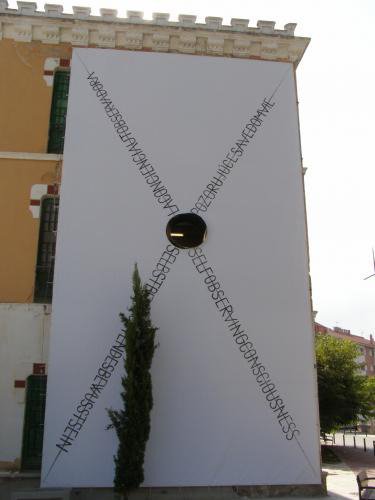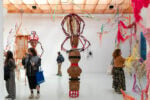Judge me not

Mostra doppia personale
Comunicato stampa
I do not think it possible to provide a rigid codification for aesthetic
judgement, since as far as I know it does not have any precise functioning
statute. However, this doesn’t mean that we can’t reflect upon this theme
and try to understand what role can judgment possibly play in a normal
artistic creation process.
Judgment is the last fundamental step in the creation process of a
contemporary artwork. It all starts with an inspiration, which sparks an
idea, which is immediately captured in a sketch, which in turn becomes the
design for the new creation. After being created, an artwork is exhibited in
a show where visitors become its main interlocutors, and also the real judges
of its aesthetic value. As a matter of fact, artists leave it to the public
– as well as to art critics – to judge how efficaciously they managed to
express their egos. In order to formulate a personal opinion about it, the
visitor must first of all draw on his/her knowledge, reorganize it in a
methodical way and then express it with a new increased wisdom1.
A judgment implies a prior reasoning, conceived as an instrument to make a
firm, balanced choice. The more resolute our reflection, the more determined
our disposition. We can only express a judgment when we activate a thought,
which gives rise to an indissolubly mutual relationship. Artists guide us
through the interpretation of their work, forcing us to draw on our cultural
background made up of contextual knowledge mixed with life experiences that
lead us to establish a continuous relationship with our past.
Nevertheless, what if the artwork judged the visitor and not the other way
round? This reversal of the normal creative process occurs concurrently with
the embryonic stage of the work, i.e. the very time when the work is
conceived. In order for an exhibition to be well received (and accordingly
well judged) by the critic, artists must take into account the kind of public
they will have to relate to. As a consequence their ideas are influenced by
the style, the taste, the socio-cultural rank and the economic position of
the “average” visitor who becomes the supreme judge of their works. And
of course this is all the more true when it comes to commissioned works.
Other factors to take into account are the venue of the exhibition and the
level of importance of the event (the Venice Biennale is more prestigious
than an exhibition in a small gallery). From all this we can infer that the
artist – indentified with his/her creation – judges the visitor and not
the other way round.
Keyhole by Giulia Manfredi is a little house symbolizing intimacy. Visitors
approach it by climbing a few mirrored steps whose function is to invite the
viewers to peep through the keyholes located on the two sides. On one side a
dazzling light impresses the image of the lock on the viewers’ retinas as
soon as it catches their eye. On the other side we are surprised by a stormy
forest crisscrossed by lightnings and beaten by rain. In both cases we
can’t help but bending down to peep into the house with the aim of judging
it immediately for how it looks and what it hides inside. But we can’t,
actually, because it’s the house that judges us - first through the
dazzling light, then by showing us a reality (the forest) that we find out to
be a metaphor of our tormented inner selves. The voyeuristic component is
very strong in this work, but once again it is the work that spies on us. In
its immobility it observes and witnesses the social, political and mood
changes of the society that surrounds it. In other words, the work is
silently alive, and it leaves in us signs of its existence that materialize
in the form of a dazzling light or of emotions (the forest).
With Il pozzo Manfredi totally disrupts the visitors’ optics. They look
into the well to see its bottom and they realize that they are actually in
the bottom. In fact, they see a person – reproduced in a video – who
looks at them and launches coins in their direction. Water flowing slightly
above the monitor makees the mechanism of inversion even more real and
efficacious, leading the viewers to believe that they are below the water
flowing at the bottom of a well.
The two works by Giulia Manfredi are an attempt to take a revenge on
extremely curious and intrusive spectators, and her determination to
destabilize them by playing with their perceptions and expectations.
Martin Vongrej with The one direction in the universe explores the virtuality
of real life through the rotation of square, round and rectangular mirrors
that compose his installation. The square mirrors placed laterally rotate in
different directions from each other and represent positiveness and
negativeness, yes and no. At the centre of the work a never-stopping
rectangular mirror creates a play of reflexes symbolizing humans faced with
the questions posed by life everyday. The X on the circular mirror, instead,
indicates the only possible direction from which one can look at the
universe.
The one direction in the universe decides whether the spectator can become or
not part of its world.
Manuela Valentini



